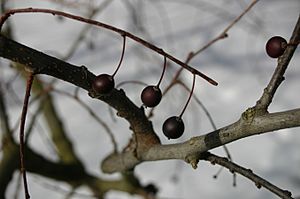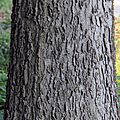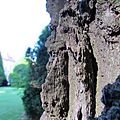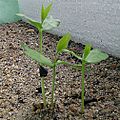Common hackberry facts for kids
Quick facts for kids Common hackberry |
|
|---|---|
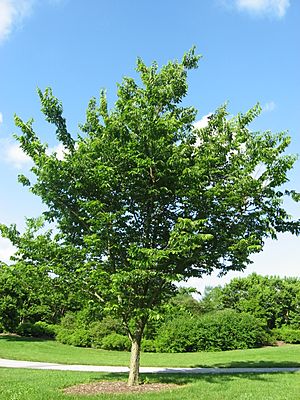 |
|
| Conservation status | |
| Scientific classification | |
| Genus: |
Celtis
|
| Species: |
occidentalis
|
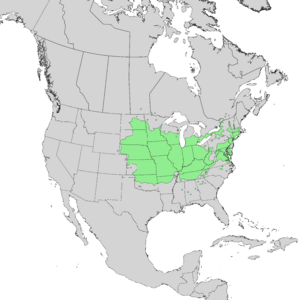 |
|
| Native range | |
The Celtis occidentalis, often called the common hackberry, is a large deciduous tree that grows naturally in North America. A deciduous tree loses its leaves every autumn. People also know it as the nettletree, sugarberry, beaverwood, northern hackberry, or American hackberry. It's a type of hardwood tree, which means its wood is dense and strong. The wood is usually light-colored, from yellowish-gray to light brown, sometimes with yellow streaks.
You can easily tell the common hackberry apart from other trees by its special bark. It looks like cork and has bumpy, wart-like spots. Its leaves are also unique because they are not perfectly even on both sides and feel rough. In the autumn, this tree grows small fruits that change from orange-red to dark purple. These fruits often stay on the tree for several months! The common hackberry can sometimes be confused with the sugarberry tree. The easiest way to tell them apart is by where they grow and their leaves. The common hackberry has wider, rougher leaves than the sugarberry.
Contents
What the Common Hackberry Looks Like
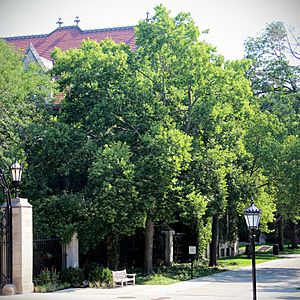
The common hackberry is a medium-sized tree, usually growing about 9 to 15 meters (30 to 50 feet) tall. It has a thin trunk. In the best places, like the southern Mississippi Valley, it can grow much taller, up to 40 meters (130 feet)! This tree has a nice round top and branches that hang down. It likes rich, moist soil, but it can also grow on rocky hillsides. Its roots spread out, and the tree grows quickly. In the western parts of its home range, trees can still reach about 29 meters (95 feet). A hackberry tree can live for a long time, probably between 150 and 200 years if conditions are perfect.
The bark of the hackberry tree is light brown or silvery gray. It has thick, flat scales and often feels rough with bumps. This pattern is very easy to recognize. On younger trees, the bark pattern is even more noticeable. The uneven ridges look like layers of rock when you look at them from the side. The dips in the bark can be as deep as an adult's finger!
The small branches are thin and change color from light green to reddish-brown, then to dark reddish-brown. In winter, the tree has small, flat, light brown buds that are about 0.6 cm (0.25 inches) long. These buds are found where the leaves meet the stem.
The leaves grow one after another along the branches. They are shaped like an egg or a spear, often slightly curved, and are about 5 to 12 cm (2 to 4.75 inches) long and 3 to 9 cm (1.25 to 3.5 inches) wide. The base of the leaf is usually uneven, and the tip is pointed. The edges of the leaves are toothed, except for the very bottom part, which is smooth. Each leaf has three main veins that stand out. When they first grow, the leaves are pale yellow-green and soft. When they are fully grown, they are thin, bright green, and rough on top, but paler green underneath. In autumn, they turn a light yellow color. The leaf stems are thin, slightly grooved, and hairy.
The flowers are greenish and appear in May, shortly after the leaves. They are special because a single tree can have three types of flowers: male flowers, female flowers, and flowers that have both male and female parts. They hang down on thin stems.
The outer part of the flower, called the calyx, is light yellow-green and has five parts that are almost separated to the base. There is no colorful part like petals.
The male parts of the flower, called stamens, are five in number. They have white, smooth stalks that are slightly flat. When the flower opens, these stalks straighten up. The anthers, which hold the pollen, open lengthwise.
The female part of the flower, called the pistil, has a two-part tip and a single-chambered ovary that holds the seeds.
The fruit is a soft, round or oval-shaped berry, about 0.6 to 1 cm (0.25 to 0.38 inches) long. It has the remains of the style (part of the pistil) at its tip. When ripe, it turns dark purple. It grows on a thin stem and ripens in September and October. These berries often stay on the branches all winter long. The hard inner part of the fruit contains a lot of a natural mineral called aragonite.
Where the Common Hackberry Grows
The common hackberry grows naturally in North America. You can find it from southern Ontario and Quebec in Canada, through parts of New England, south to North Carolina (in the Appalachia region), west to northern Oklahoma, and north to South Dakota. The area where hackberry grows can overlap with the sugarberry tree, which makes it tricky to know exactly where each species grows in the South. In the western part of its range, the common hackberry is sometimes confused with the smaller netleaf hackberry, which has similar bark.
Hackberry trees can grow in many different places. However, they prefer low-lying areas near water and soils that have a lot of limestone. How well it can grow in the shade depends on the conditions. If conditions are good, young hackberry trees can grow even under a thick forest canopy. But in less ideal conditions, they need more sunlight.
Hackberry and Nature
The leaves of the hackberry tree are sometimes eaten by tiny insects that create galls (small bumps) on the leaves. These insects don't usually harm the tree much. Many insects and fungi can cause dead branches or roots of the tree to decay quickly.
The small hackberry fruits are a food source for many birds, like robins and cedar waxwings, and also for mammals. Most of the seeds are spread by animals that eat the fruit, but some seeds are also carried by water.
This tree is also important for butterflies! It's a host plant for the larvae (caterpillars) of the hackberry emperor butterfly. This means the butterfly lays its eggs on the hackberry leaves, and the caterpillars eat the leaves as they grow.
How People Use Hackberry Trees
The wood of the hackberry tree is light yellow, heavy, soft, and has a coarse grain. It's not very strong and rots easily, so it's not often used for commercial purposes. However, it is sometimes used for fences and simple furniture.
Hackberry trees are not used as street or landscape trees very often, even though they can handle city conditions well. The cities of Sombor in Serbia and Bratislava, the capital of Slovakia, are known for using hackberry trees a lot along their streets.
The tree's small, pea-sized berries are safe to eat and ripen in early September. Unlike most fruits, these berries are surprisingly high in calories from fat, carbohydrates, and protein. These calories are also easy to digest without needing to cook or prepare the berries. Native American tribes like the Omaha ate the berries as a snack. The Dakota people used them to add flavor to meat, pounding them finely, seeds and all. The Pawnee tribe also pounded the berries, added a little fat, and mixed them with roasted corn.
Images for kids
See also
 In Spanish: Almez americano para niños
In Spanish: Almez americano para niños



